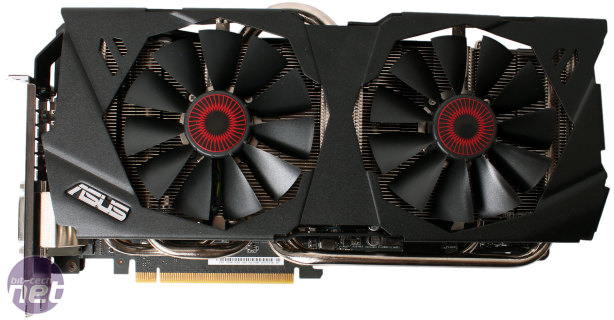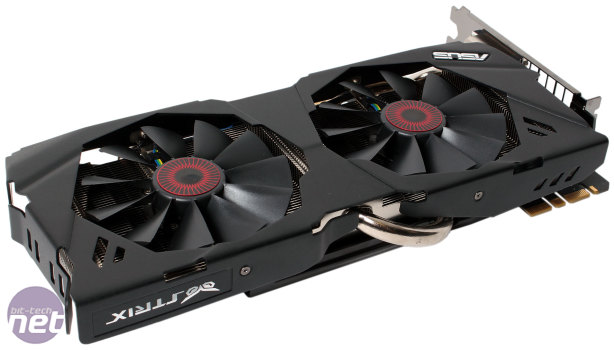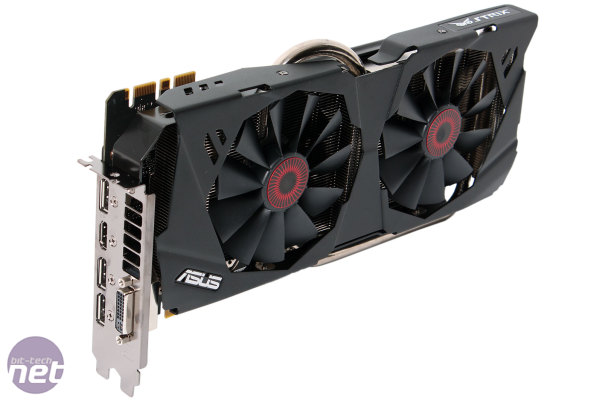
Performance Analysis
On average, the Strix GTX 980 performs somewhere in between the stock GTX 980 and the Gigabyte GTX 980 G1 Gaming in every test; exactly what you'd expect given the default frequencies of each of these models. There is one odd result, however. In Crysis 3 at 1440p, the minimum frame rate actually dips below the stock GTX 980. However, the average is higher, and the minimum can vary slightly in this test on occasion.In Battlefield 4 the overclock is enough for the Strix GTX 980 to overtake the GTX 780 Ti and Titan Black at 1440p. The 1fps improvement at 4K, however, is not enough to crack the 30fps barrier on the minimum frame rate like the faster Gigabye card does. The GTX 980 is already easily the best single GPU card in BioShock Infinite, but results improve here on average by 4 percent. In Crysis 3, the ASUS card is unsurprisingly not as fast as Gigabyte's, though neither is able to keep 4K playable. In Skyrim, the Strix GTX 980 has no issues at either resolution, though the overclock isn't enough for it to post any improvement over the reference card at 4K.
In Unigine Valley, the ASUS Strix GTX 980 improves on stock performance by 4 percent at 1080p and 6 percent at 1440p. Furthermore, Gigabyte's card is faster by another 4 percent on average.
We observe 20W higher system power consumption than stock using the ASUS card, but 30W lower than the Gigabyte one, suggesting this card is slightly more efficient. That said, all Maxwell cards are very efficient when compared to the wider graphics card market.
The delta T in our thermal stress test emerges as 8°C warmer than the Gigabyte G1 Gaming card, but it's still 12°C lower than the stock cooler. The better news, however, is that this model is significantly quieter than both; we weren't able to hear it over the rest of our system at all. At the end of the test, the two fans were reported by GPU-Z as spinning at around 1,150RPM, compared to the three smaller Gigabyte fans running at around 2,350RPM. Of course, even the stock cooler isn't particularly loud, but as with the Strix GTX 970 ASUS appears to have opted for very low noise as a priority rather than very low temperatures and more aggressive boosting like Gigabyte. We think ASUS's route makes more sense, as it's still able to cool the GTX 980 GPU very effectively at this lower noise level.
As mentioned, the overclocking results were pretty impressive. The final base frequency was just 10MHz below what we managed with the Gigabyte GTX 980 G1 Gaming, though the more aggressive boost profile of the latter saw it boosting to around 35MHz more under load. This is still a very small difference, as evidenced by the overclocked test results. The ASUS and Gigabyte cards pump out the exact same frame rates in Battlefield 4, while Crysis 3 gives one card a 1fps minimum advantage and the other a 1fps advantage on average. Finally, in Unigine Valley, Gigabyte's slightly higher boosting sees its card achieve a score just 1 percent above that of ASUS. The temperature of the Strix GTX 980 climbed by about 4°C and the fans reached around 1,400RPM, but ASUS's card consumed around 15W less than Gigabyte's when overclocked and retained its noise advantage too, staying noticeably quieter than both the reference model and Gigabyte's.
Conclusion
In the end, what's left is another highly desirable but very expensive graphics card – we suspect this description will apply to the majority of GTX 980 partner cards. Gigabyte's card from last week is faster out of the box, but also noisier (though not loud) and slightly longer. However, when overclocked, the cards are basically equal, as the Strix GTX 980 offers plenty of headroom here, yet the ASUS card is still quieter. It also offers a semi-passive mode, which neither the Gigabyte nor reference cards do, so during idle periods you don't need to worry about noise whatsoever. It's again irritating to see such an expensive card with no memory overclock, but the Samsung memory chips have been worthy overclockers in all the cards we've seen so far, so users should be able to tweak theirs with ease.Price is again the main concern here. This card costs 40 percent more than the Strix GTX 970, which has a similar cooler. Granted, this model has a few more power phases, heat pipes and display outputs, but even so it's a steep increase given the gentler climb in performance, though this is true when comparing virtually any GTX 980 and GTX 970 cards. As such, a pair of GTX 970 or even AMD R9 290 or 290X cards would have the capacity to offer a much better price to performance ratio. Of course, SLI and CrossFireX are heavily reliant on software for effective scaling, and heat and noise will be of greater concern, while two cards isn't an option for mini-ITX users. For single GPU performance, this card fits easily within the 'as good as it gets' category, but comes with a hefty premium as a result.

-
Performance39 / 40
-
Features30 / 30
-
Value19 / 30


MSI MPG Velox 100R Chassis Review
October 14 2021 | 15:04












Want to comment? Please log in.